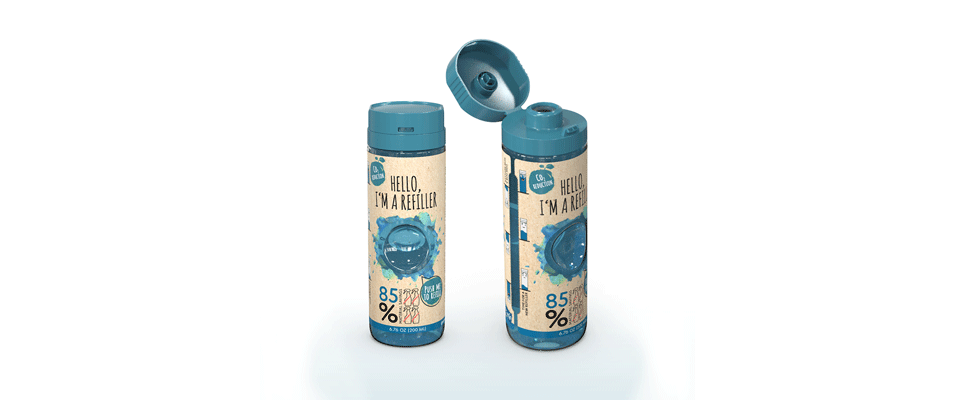- New, environmentally friendly, 200-ml refill packaging solution for multiple doses of household cleaning products and chemicals
- Takes place of four separate spray bottles and trigger sprayers
- Bottles made from HDPE, PP, or PET material
- Practical fliptop cap with guiding nozzle
- Accurate and consistent dosing and integrated level indicator
- Intelligent refill cycle reduces plastic use by up to 85 percent
Refilling is one example of where sustainability starts. Why buy a new spray bottle every time you need household cleaner when there is now an efficient and eco-friendly way to refill your bottle? This was the motivation for Greiner Packaging to team up with its in-house design agency DesPro and develop a new refill concept for plastic spray bottles for household chemicals.
The many benefits of refilling
The newly developed 200-milliliter refill bottle is made of HDPE, PP, or PET material and weighs just around 16 grams in its original form. It contains 200 ml of concentrate, which later produces ten times its liquid volume across four spray bottle refills. Each safe, 50 ml dose can also be adjusted to 30 ml or 40 ml. This is done through a special valve and a guiding nozzle that fits into all standard spray bottles. Thanks to their shape, the new refill bottles make it easy for consumers to squeeze out their contents in consistent doses – plus, they can be provided with an attractive label. In addition, the nonremovable, hinged snap-on lid is fitted with a safety lock. And a user-friendly level indicator completes the list of practical features. As a result, the newly designed bottle is well placed to meet all current market requirements.
Up to 85 percent less plastic used
Greiner Packaging is committed to advancing a sustainable circular economy that, in addition to recycling, also delivers reductions in plastic material use. Consumers can get as much out of a single new refill bottle as they otherwise could from four separate plastic spray bottles, including trigger sprayers – over its lifecycle, original 500 ml spray bottles and trigger sprayers can produce 10,000 individual 1-ml sprays, ensuring that they can be used to its maximum potential. “It goes without saying that we were primarily aiming to reduce material use when we developed the new spray bottle multidose refill. The amount saved increases exponentially throughout the intelligent refill cycle – ultimately yielding a reduction of up to 85 percent. Each year, this could save up to 1,000 metric tons of plastic, if we assume that there are 20 million standard spray bottles a year. In order to be sustainable, reuse of a spray bottle and its refills must become a new normal,” says Tõnu Kundla, International Business Development Manager at Greiner Packaging.









